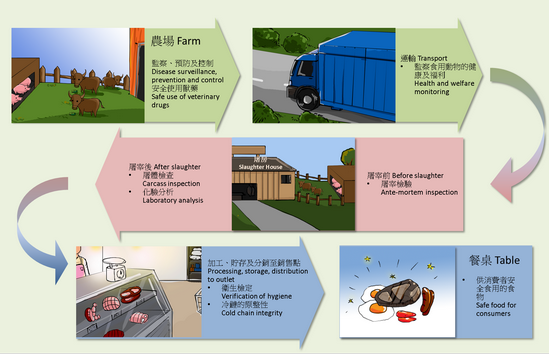
Food Safety Focus (126th Issue, January 2017 ) – Food Safety Platform
One Health and Food Safety – From Farm to Table
Dr. Cherrie NG, Veterinary Officer,
Risk Assessment Section,
Centre for Food Safety
In the previous issue, we introduced the concept of One Health and some key issues of One Health related to food safety. In this issue, we will put more focus on foodborne diseases, foodborne zoonoses in particular, under the food safety aspect of One Health. The human-animal-ecosystem interface is important to safeguard public health and encompasses all direct and indirect human exposure to animals and animal products and to the various environments and ecosystems that we all share. Collaboration and coordination under the One Health concept can help to improve prevention and control of zoonotic diseases, better monitor disease threats and care for the health of livestock and the environments that they are raised in, all of which can contribute to improving food safety monitoring.
Foodborne Zoonoses – A Type of Foodborne Diseases
Foodborne diseases result from ingesting foodstuffs contaminated with microorganisums or chemicals. Prevention of foodborne diseases is a crucial part of food safety because they are an important cause of morbidity and mortality globally. Foodborne zoonoses, being a type of foodborne diseases, are foodborne diseases that are naturally transmitted between vertebrate animals and humans, examples are salmonellosis and campylobacteriosis. According to the World Health Organization, millions of people get sick each year due to foodborne zoonoses.
Prevention of foodborne zoonoses starts where the food is produced, at the farm, to where the food is consumed, on the table, because contamination can occur at different stages of the process. Taking poultry meat as an example, at the farm, the chickens can acquire bacteria such as Salmonella and Campylobacter from the environment or feed, resulting in infection in the chickens. During slaughter, the carcasses can be contaminated, by coming into contact with the intestinal contents of the chickens. Subsequently, human salmonellosis and campylobacteriosis can arise from consuming the products derived from the infected poultry if they have not been properly treated.
Collaboration under the One Health Approach
With the collaboration under the One Health approach, food safety can be improved and better monitored by involving parties from relevant discipline to the appropriate stage(s) of food production (see Fig).

Food Safety - From Farm to Table
At the farm where livestock are raised for food, there should be surveillance, prevention and control of animal diseases and safe and legitimate use of veterinary drugs should be ensured. At the farm level, the veterinary profession plays an important role and collaboration of laboratory resources and global disease data sharing can greatly facilitate better management and lower economic losses upon disease outbreak with better prevention and control of diseases. Besides health of the animals, the environment is also related to health of consumers. Contaminants in the farm may be ingested by food animals, the safety and quality of the food products would be jeopardised and subsequently affect the consumers.
Food animals are transported to slaughterhouse after leaving the farm. Before slaughter, there should be an ante-mortem inspection check of the animals to assess the health status of the live animals. After slaughter, the carcasses should be inspected and samples should be taken for laboratory analysis. For the processing, storage and distribution after slaughter and subsequently at the outlet, such as supermarkets and restaurants, there should be verification of hygiene and the cold chain integrity should be maintained. All the steps with collaborative efforts of multiple disciplines, both locally and internationally, are important to provide safe food on the table and cooperation among different parties is essential.


